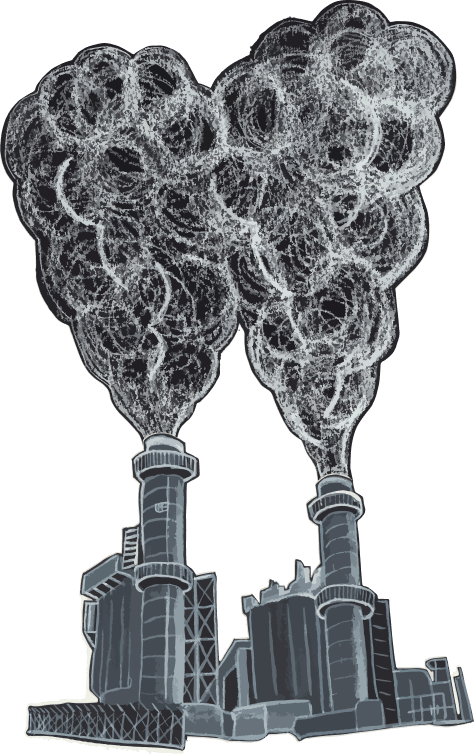Louisiana
Back to mapTo get to zero by 2050, Louisiana must cut emissions by 3.7% a year
Emissions in Louisiana
Million metric tons of carbon dioxide (CO2) equivalent (MTCO2e
) emissions
Note: Grey area indicates missing data due to processing delays.
Source: WRI, Mar 2021
This is how we're going to do it
- Boilers and furnaces with heat pumps
- Gas stoves with electric induction stoves
- No-till farming to keep CO2 in the soil
- Capturing methane leaks from landfills
- Capturing CO2 to make emissions-free concrete
- Burning green hydrogen to make emissions-free steel
- Plugging methane leaks from gas pipelines
Decarbonize Our Buildings
2% of Louisiana's climate pollution comes from buildings.
We burn fossil fuels to heat our air, water, and food.
To cut this pollution...
Let's electrify our heat!
We'll replace...
...in all of Louisiana's 2.2 million buildings.
In fact, 59.1% of appliances in buildings in Louisiana are already fossil fuel free!
That means we only need to electrify the remaining 888,000 dirty buildings in Louisiana. That's around 33,000 per year.
Source: Microsoft, Mar 2021; NREL, Dec 2021Electrifying all buildings cuts 2% of the pollution.
Decarbonize Our Transport
20% of Louisiana's pollution comes from cars, trucks, trains, and planes.
But mostly from cars.
To cut this pollution,
your next car must be electric.
Or consider going car-free with public transit, bikes/e-bikes, car share, or other alternatives!
There are 1.3 million vehicles in Louisiana and 2,000 are already electric (0.1% of the total).
We need to electrify (or replace) the remaining 1.3 million gas-powered vehicles. That's around 49,000 a year.
Source: DOT, Feb 2021Electrifying all transportation cuts 20% of the pollution.
Decarbonize Our Power
14% of Louisiana's pollution comes from burning coal, gas, and oil to make power.

That's because of how power is generated in Louisiana today.
Power Generation in the State of Louisiana (2020)
But there's already 19% carbon-free electricity generation in Louisiana!
To clean up the emissions from the polluting power plants we need to replace all fossil fuel power plants with solar and wind farms.

...and find good jobs for those workers.
Current Fossil Fuel Power Plants in Louisiana
3 coal plants
Big Cajun 2
Pointe Coupee County
2,633 MW
Brame Energy Center
Rapides County
1,707 MW
Dolet Hills Power Station
DeSoto County
721 MW
46 gas plants
Ninemile Point
Jefferson County
2,791 MW
Acadia Power Station
Acadia County
1,389 MW
Little Gypsy
St Charles County
1,251 MW
St. Charles Power Station
St Charles County
1,000 MW
1 oil plant
Nelson Industrial Steam Company
Calcasieu County
1,597 MW
But wait!
It's not enough to replace our power plants with wind and solar farms.
To power our electric cars and buildings, we need two times the electricity we have today.
In all, we'll need to build 5,000 megawatt (MW) of wind power and 7,000 MW of solar power.
Since the average wind turbine provides 2.75 MW of peak capacity, Louisiana would need to install about 2,000 turbines.
Since Louisiana already has 0 MW of wind and 49 MW of solar, that's 5,000 MW of wind power we need to build and 7,000 MW of solar power. That's around 199 MW of wind power and 251 MW of solar power a year.
Source: EIA, Apr 2022Decarbonizing all dirty power cuts 14% of the pollution.
And gives us zero-emissions power we need to eliminate pollution from buildings and cars!
Other Emissions
The last 64% of Louisiana's climate pollution comes from other sources...
This includes farming, landfills, industry, and leaks from gas pipelines.
There's no one solution to solve these problems, but there are lots of great ideas:
That doesn't mean there's no solution, it just means that clean electrification doesn't help with these problems, and you could fill a whole book with covering all of them. We need to encourage our politicians to invest in researching new solutions and implementing existing solutions to these problems!
Ready to do your part?
Learn how to electrify your own machines and pass local policy to electrify the rest
Take Action